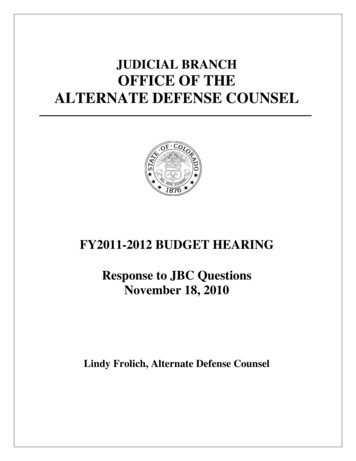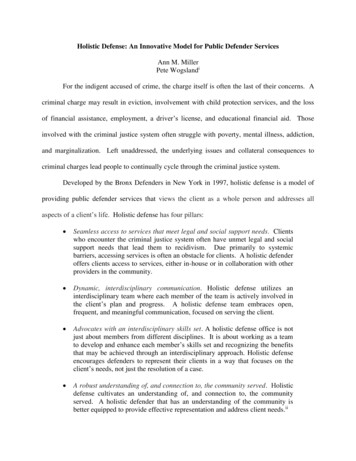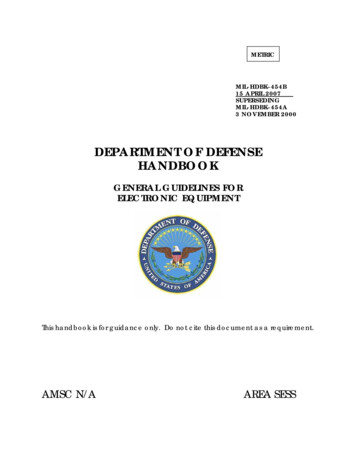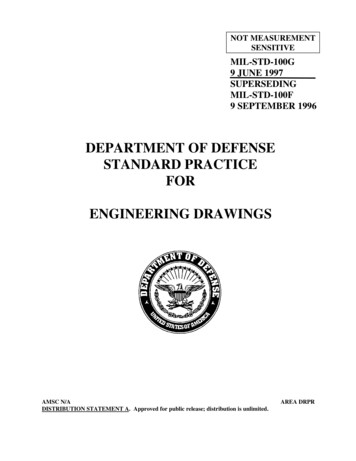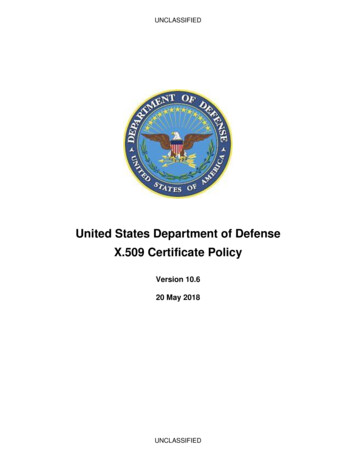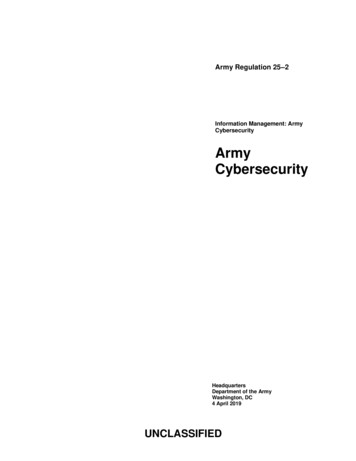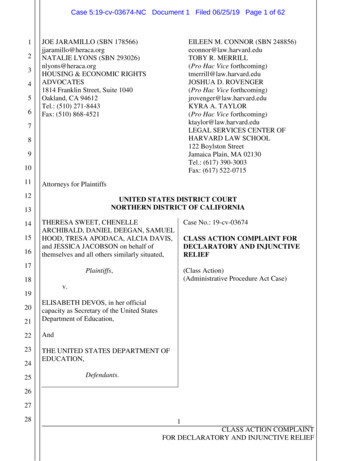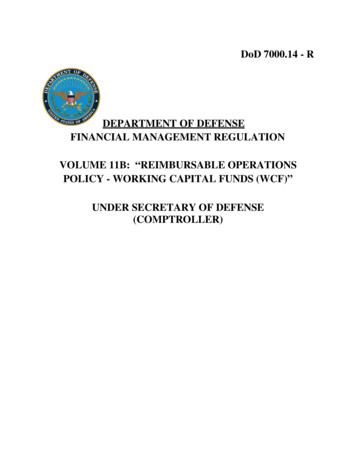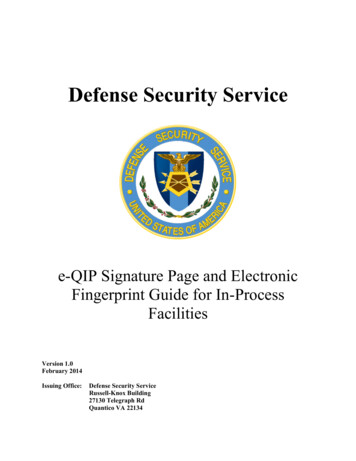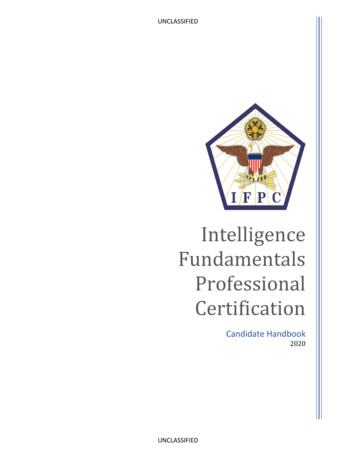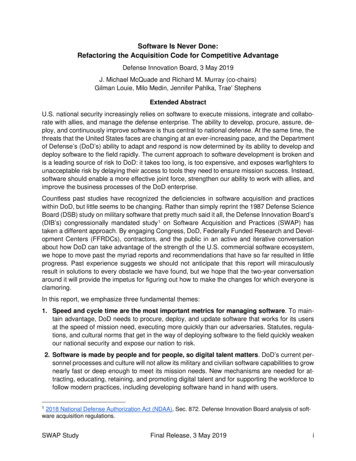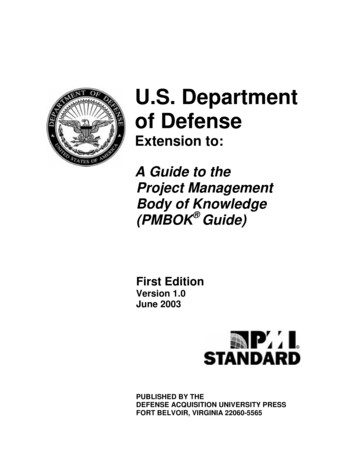
Transcription
U.S. Departmentof DefenseExtension to:A Guide to theProject ManagementBody of Knowledge(PMBOK Guide)First EditionVersion 1.0June 2003PUBLISHED BY THEDEFENSE ACQUISITION UNIVERSITY PRESSFORT BELVOIR, VIRGINIA 22060-5565
WARNINGWhile the public may freely reproduce the U.S. DoD Extension, any new work which isderivative of the underlying PMBOK Guide and any publication of excerpts from thePMBOK Guide contained in the U.S. DoD Extension in a manner which is separate fromor otherwise independent of the reproduction of the U.S. DoD Extension, may violate PMI’scopyrights and should not be undertaken.For sale by theU.S. Superintendent of Documents, Government Printing OfficeInternet: bookstore.gpo.gov Phone: (202) 512-1800 Fax: (202) 512-2250Mail Stop: SSOP, Washington, DC 20402-0001ii
Publication ProcessThis U.S. Department of Defense (DoD) Extension was developed, is published,and will be maintained under agreement between the Project Management Institute, Inc. (PMI ) and the Defense Acquisition University (DAU) as an ApplicationArea U.S. DoD Extension to PMI’s A Guide to the Project Management Body ofKnowledge (“PMBOK Guide”). This U.S. DoD Extension has been approved asa PMI Standard through the PMI Standard-Setting Process.To the extent that the U.S. DoD Extension is a derivative work from the PMBOK Guide, PMI hereby grants DAU a limited, non-exclusive, non-transferable royaltyfree license (the "License") to prepare and publish the U.S. DoD Extension as aderivative work based upon the PMBOK Guide and to publish excerpts from thePMBOK Guide in the text of the U.S. DoD Extension, as the parties may agreepursuant to the terms and conditions set forth herein.The U.S. DoD Extension is a "work of the United States Government" under theprovisions of 17 U.S.C. §105. However, while PMI does not object to publicationof the U.S. DoD Extension in “the public domain”, such consent in no way waivesPMI’s underlying copyrights to the PMBOK Guide. While the public may freelyreproduce the U.S. DoD Extension, any new work which is derivative of the underlying PMBOK Guide and any publication of excerpts from the PMBOK Guide contained in the U.S. DoD Extension in a manner which is separate fromor otherwise independent of the reproduction of the U.S. DoD Extension may violate PMI's copyrights. Furthermore, while providing these reproduction rights ofthe U.S. DoD Extension , PMI does not waiver any right to enforce its copyrights,except for the limited license given to the DAU as expressly provided herein. Tothe extent that the United States Government may be deemed to hold a copyrightto any portion of the U.S. DoD Extension, it hereby grants to PMI a limited, nonexclusive, non-transferable, royalty free license to publish and sell all such copyrighted materials, including but not limited to comments obtained by PMI in theexposure draft stage of its Standards process.PMI retains its full copyrights to the PMBOK Guide, which is available from theProject Management Institute. Individuals, organizations, and businesses interested in the licensed use of the PMBOK Guide or portions thereof may requestsuch a license on the PMI Website at: http://www.pmi.org.When significant additions or other changes to the content of the U.S. DoD Extension are made, DAU will notify PMI of those changes and submit the revisedU.S. DoD Extension for review pursuant to the PMI Standards Setting Policy andProcedures for purposes of updating the U.S. DoD Extension as a PMI Standard.Only after those changes in the revised U.S. DoD Extension have been approvedthrough the PMI Standards Setting Policy and Procedure will the revised U.S.DoD Extension be labeled and identified as a PMI Standard. PMI reserves theright to make the sole determination of whether to designate any future editionsor revised versions of the U.S. DoD Extension as a PMI Standard in accordancewith its established policy and procedures.iii
iv
ContentsPublication Process . iiiList of Figures . viiiPreface to First Edition, 2003 . ixSection I – The Project Management Framework . 1Chapter 1 – Introduction . 31.1 Background . 41.2 DoD Program Management Environment . 5Chapter 2 – The Project Management Context . 72.1 Technological Opportunities and User Needs . 82.2 Phases and Milestones . 82.3 Program Acquisition Strategy . 112.4 Key Activities . 11Chapter 3 – Project Management Processes . 12Section II – The Project Management Knowledge Areas . 13Chapter 4 – Project Integration Management .4.1 Program Plan Development .4.2 Program Plan Execution .4.3 Integrated Change Control .15162023Chapter 5 – Project Scope Management .5.1 Initiation .5.2 Scope Planning .5.3 Scope Definition .5.4 Scope Verification .5.5 Scope Change Control .313239414143Chapter 6 – Project Time Management .6.1 Activity Definition .6.2 Activity Sequencing .6.3 Activity Duration Estimating .6.4 Schedule Development .6.5 Schedule Control .475154555660Chapter 7 – Project Cost Management .7.1 DoD Staff Participants in Resource Planning.7.2 Resource Planning .7.3 Cost Estimating .7.4 Cost Budgeting .7.5 Cost Control .7.6 Setting Objectives .7.7 DoD Program Budget Execution/Funds Management .6366687582879194v
Chapter 8 – Project Quality Management . 998.1 Quality Planning . 1008.2 Quality Assurance . 1038.3 Quality Control . 105Chapter 9 – Project Human Resource Management .9.1 Organizational Planning .9.2 Staff Acquisition .9.3 Team Development .109109114115Chapter 10 – Project Communications Management .10.1 Communications Planning .10.2 Information Distribution .10.3 Performance Reporting .10.4 Administrative Closure .120121121124125Chapter 11 – Project Risk Management .11.1 Risk Management Planning .11.2 Risk Identification .11.3 Qualitative Risk Analysis .11.4 Quantitative Risk Analysis .11.5 Risk Response Planning .11.6 Risk Monitoring and Control .127132135137144146148Chapter 12 – Project Procurement Management .12.1 Procurement Planning .12.2 Solicitation Planning .12.3 Solicitation .12.4 Source Selection .12.5 Contract Administration .12.6 Contract Close-out .153154156157160161163Section III – Defense Acquisition Knowledge Areas . 165Chapter 13 – Project Systems Engineering Management .13.1 Systems Engineering Planning .13.2 Systems Engineering Activities .13.3 Analysis and Control .167167170172Chapter 14 – Project Software Acquisition Management . 17914.1 SAM Activities . 180Chapter 15 – Project Logistics Management . 18915.1 Logistics Management . 190Chapter 16 – Project Test and Evaluation Management . 19916.1 T&E Planning . 19916.2 T&E Execution and Reporting . 202Chapter 17 – Project Manufacturing Management .17.1 Influencing Design .17.2 Planning for Production .17.3 Production .205206210214vi
Section IV – Appendices . 219Appendix A – Evolution of the U.S. DoD Extension toPMBOK Guide . 221Appendix B – Contributors . 225Appendix C – Glossary . 228vii
List of FiguresFigure 1-1.Figure 1-2.Figure 1-3.Figure 2-1.Figure 4-1.Figure 4-2.Figure 4-3.Figure 4-4.Figure 5-1.Figure 5-2.Figure 6-1.Figure 6-2.Figure 6-3.Figure 6-4.Figure 6-5.Figure 6-6.Figure 6-7.Figure 7-1.Figure 7-2.Figure 7-3.Figure 7-4.Figure 7-5.Figure 7-6.Figure 7-7.Figure 11-1.Figure 11-2.Figure 11-3.Figure 11-4.Figure 13-1.Figure 13-2.Figure 15-1.Figure 15-2.Figure 15-3.Figure 15-4.Figure 15-5.Figure 17-1.Primary Linkages Between PMI PMBOK Guide KnowledgeAreas and Defense-Intensive Knowledge Areas . 4The Program Manager’s Environment . 5The Major Decision Support Systems . 6Current DoD Acquisition Life-Cycle Process . 7Earned Value and the Contracting Process . 22PMB Budget Allocation . 25Earned Value Management Methods . 26Contract Performance Measurement Data . 27Mission Need Determination . 33Science and Technology Linkage to Acquisition Process . 35IMP vs. IMS Relationships . 48IMS: Managing Schedule Progress . 49Program Structure (Example) . 49Responsibility Assignment Matrix . 53IMS Example in Gantt Chart Format . 58IMS PERT Chart Showing Dependencies . 59Schedule Status Symbols/Legend . 62Funding Cycle . 64Future Years Defense Program (FYDP) Structure . 69PPBES Planning and Programming Phases . 70PPBES Programming and Budgeting Phases . 72Life-Cycle Cost Categories . 81Interrelated Budget and Cost Document Terms . 81The Apportionment Process . 97DoD Risk Management Structure . 129Risk Management Process Model . 131Critical Industrial Processes . 140Comparison of the Three Processes . 142The Systems Engineering Process . 170Technical Performance Tracking Chart . 174Logistics Management Process . 189System Operational Effectiveness and Product Support . 191Operational Availability . 192Normal Cost Distribution (Generic DoD Acquisition Program) . 193Logistics Elements . 194The Role of Manufacturing in the Acquisition Process . 206viii
Preface to First Edition, 2003This document is the first edition (2003) of a U.S. Department of Defense (DoD)Extension to the Project Management Institute’s (PMI ) A Guide to the Project Management Body of Knowledge (PMBOK Guide) 2000 Edition.The primary purpose of this document is to identify and describe defense applications of the core project management knowledge areas contained in the PMBOK Guide,as well as those defense-intensive knowledge areas not contained in the Guide. It is important to understand that this is an extension to the PMBOK Guide, and is not intended to be a stand-alone document. The PMBOK Guide is a valuable document in itsown right and its principles need to be understood and practiced by DoD Program Managers (PM).This Extension generally follows United States Department of Defense (hereinafterreferred to as DoD) acquisition system policies and procedures (principally found in theDoD 5000 series directives – DoDD 5000.1, DoDI 5000.2, and Interim Defense Acquisition Guidebook (IDAG)). However, many of the concepts are generic to defense acquisition worldwide. For more information about the acquisition systems of important U.S. Allies, see the following two documents published by the Defense Acquisition UniversityPress: A Comparison of the Defense Acquisition Systems of Australia, Japan, SouthKorea, Singapore, and the United States. A Comparison of the Defense Acquisition Systems of France, Great Britain,Germany, and the United States.These documents are available at http://www.dau.mil/pubs/pubs-main.asp.Department of Defense (DoD) acquisition directives, instructions and guidance (in the5000 series) are published and updated periodically and provide mandatory and discretionary information to effectively manage defense system acquisition. Consistent withthese documents the Under Secretary of Defense (Acquisition, Technology, and Logistics) (USD (AT&L)), has published a listing of AT&L Management Initiatives which areorganized into five goals. The five goals and their objectives (which are subject to regular revision and status reporting), are noted below: Goal # 1. Objective: Achieve credibility in acquisition and logistics supportprocess Reduce Cycle Time – A key part of this goal is the use of realistic costestimates and fully funding those estimates; plus the use of evolutionary acquisition and spiral development as ways to deliver systems more quickly and atlower cost.Goal # 2. Objective: Revitalize quality and morale of the DoD acquisition,technology and logistics workforce – Progress can be made on this goal bygiving acquisition managers more control in recruiting and job classification , andimproving the training and education of the AT&L workforce.ix
Goal # 3. Objective: Improve health of defense industrial base – Work onachieving this goal involves increasing progress and performance-based payments for completed defense work, and working to incentivize defense corporations to eliminate unused industrial infrastructure.Goal # 4. Objective: Rationalize the weapon systems and infrastructure withdefense strategy – Involves transformation of the U.S. military and defense establishment over time into a capabilities-based approach and force structure.Goal # 5. Objective: Initiate high leverage technologies – This goal focuses onleveraging technologies to create warfighting capabilities, systems, and strategies of the future.Each of the goals are further broken down into specific initiatives and actions neededto accomplish the goals. This U.S. DoD Extension is a direct product of Goal #1.Special thanks are due to Mr. Norman Bull for extensive research, editing, and support in preparing the initial draft (in 2002) of the U.S. DoD Extension under contractDADW35-01-P-0079. Thanks are also due to those members of the Defense AcquisitionUniversity faculty, private consultants, and members of the U.S. defense industry, (allnoted in Appendix B), who originated, edited, and reviewed the text. This list of contributors includes Mr. Fred Ayer, who was the driving force and main proponent of the Extension; without his leadership and knowledge of PMI processes, this project would neverhave gotten off the ground. Thanks are also due to Ms. Pat Bartlett, Bartlett Communications, and to Ms. Debbie Gonzalez for their detailed proofreading, editing and formattingof this document.The Defense Acquisition University is the controlling agency for this U.S. DoDExtension. Comments and recommendations relating to the text are solicited. You areencouraged to fax such comments to the DAU Press, 703-805-2917.William W. Bahnmaier, PMPProfessor (Retired), Systems Acquisition ManagementDefense Acquisition Universityx
SECTION ITHE PROJECT MANAGEMENT FRAMEWORK1. Introduction2. The Project Management Context3. Project Management Processes1
2
Chapter 1IntroductionThe nine knowledge areas identified in the PMBOK Guide are applicable to the DoD inthe development, production, and fielding of defense systems. The nine areas, whichhave the same chapter numbers in this Extension as in the PMBOK Guide, are depictedin Figure 1-1 “Wheel.” While the nine areas are the core of DoD’s project managementconcept, there are five other defense-intensive knowledge areas or processes that are keyto defense acquisition. These five defense-intensive areas, as well as defense-relatedaspects of the basic nine knowledge areas, are addressed herein. The new areas andtheir respective position in this U.S. DoD Extension are: Chapter 13: Project Systems Engineering Management. Chapter 14: Project Software Acquisition Management. Chapter 15: Project Logistics Management. Chapter 16: Project Test and Evaluation Management. Chapter 17: Project Manufacturing Management.The format of this Extension is keyed to the structure contained in the PMBOK Guide,including the PMBOK Guide’s input — tools and techniques — output methodology todescribe the knowledge areas as they relate to defense acquisition. Inputs, tools andtechniques, and outputs taken directly from the PMBOK Guide are printed in regular typewhereas defense-specific inputs, tools and techniques, and outputs added through thisExtension are printed in bold type. Additionally, the text regarding inputs, tools andtechniques, and outputs indicates additional defense-specific material or else the reader isreferred back to the PMBOK Guide.Chapter titles for Chapters 1-12, and sub-chapter (that is, PMBOK Guide processes)paragraph numbers, titles, and summary descriptive words for each sub-chapter appearing on the first page of Chapters 4-12 are all taken from the PMBOK Guide except forthree additional sub-chapter items added in Chapter 7.At this point we will address some basic DoD processes and terminology as a meansof orienting the reader.3
1.1 BackgroundWhile the PMBOK Guide knowledge areas and the defense-intensive areas have distinctive characteristics, they are related in that the defense-intensive areas each rely onseveral of the PMBOK Guide areas to be successful. A description of the relationshipbetween the core PMBOK Guide knowledge areas and the defense-unique knowledgeareas is shown in Figure 1-1.Note that many of the defense-intensive knowledge areas cut across the PMBOK Guide knowledge “pie.” There is room for debate regarding the linkages as shown in thechart. In this Extension, we will describe each of the defense-peculiar areas separately,while also describing their links to the core PMBOK Guide knowledge areas. It should bementioned that much work on identifying the defense-intensive knowledge areas is contained in a thesis presented by Captains Korina L. Kobylarz and Gregory D. Best, USAF,in 1991, titled “Establishing a Department of Defense Program Management Body ofKnowledge.” Information contained in that thesis, as well as other documents and articlespublished over the past several years, have been utilized in developing this Extension.Figure 1-1. Primary Linkages Between PMI PMBOK Guide Knowledge Areas andDefense-Intensive Knowledge Areas1.1.1 “Project” versus “Program”The PMBOK Guide describes a “program” as a group of projects managed in acoordinated way to obtain benefits not available from managing them individually. The4
PMBOK Guide also notes that many programs include elements of ongoing fieldoperations. It states: “For example: The XYZ airplane program includes both the project orprojects to design and develop the aircraft, as well as the ongoing manufacturing andsupport of that craft in the field.” Defense system development, production, and fielding isnormally described as “program management”; that term will be used throughout thisExtension. In addition, the material in this Extension tends to be oriented more toward theinputs, processes, and output of Government program management as opposed to theindustry/contractor program or project manager. Nevertheless, many of the sameprinciples and practices (and increasingly commercial practices) apply to both, and theintent is to include these defense industry and commercial practices where appropriate.1.2DoD Program Management EnvironmentProgram management in the DoD is characterized by a continuing interface between theCongress, the Executive Branch (DoD, developer and buying commands, user commands), and industry. Figure 1-2 shows those relationships and how the defense (Government) program manager (PM) and Program Management Office (PMO) must workwithin that environment. Similar environments exist in other industrialized countries aswell.Figure 1-2. The Program Manager’s EnvironmentThe DoD acquisition processes and procedures are directed and guided by three keydocuments: DoD Directive (DoDD) 5000.1, DoD Instruction (DoDI) 5000.2, and the InterimDefense Acquisition Guidebook (IDAG). Revised 5000 Series documents DoDD 5000.1and DoDI 5000.2 were published on 12 May 2003. The “old” DoD 5000.2-R has beenrepackaged into the IDAG, which is dated 30 October 2002.Direction and instructions from the 12 May 2003 versions of the Directive and Instruction along with guidance from the IDAG are depicted in the text and charts in thisExtension. To keep the text relatively generic and free from needing continual changes,5
references to these three documents will be made throughout this Extension in terms ofthe “5000 Series.”Information in this series covers: a.) The Defense Acquisition System (DoDD 5000.1),where management principles for all DoD programs are described; b.) Operation of theDefense Acquisition System (DoDI 5000.2), which establishes a simplified and flexiblemanagement framework for translating mission needs and technology opportunities intostable, well-managed and affordable acquisition programs/systems; and c.) the IDAG which provides guidance on procedures for operation of the acquisition system and isbased on an integrated management framework formed by three primary decision supportsystems: the Requirements Generation System, the Defense Acquisition System, and thePlanning, Programming, and Budget System (PPBS). This integrated managementframework is depicted in Figure 1-3.The 5000 Series provides a general approach for managing all defense acquisitionprograms, while recognizing that every technology project and acquisition program isunique and the process described in the instruction must be tailored to reflect these uniqueattributes.Figure 1-3. The Major Decision Support SystemsWhen examining DoD acquisition processes and procedures, it is important tounderstand that the Government PM is the direct customer of the contractor (defenseindustrial firm) project manager. On the other hand, the Government PM is the supplier ofthe product to field units (“users”). The “users” (also referred to as “warfighters”) are thedirect customers of the Government PM.6
Chapter 2The Project ManagementContextThis chapter of the U.S. DoD Extension of the PMBOK Guide provides a brief overview ofthe DoD defense acquisition life cycle. The defense acquisition life-cycle model/ processthat is described in Figure 2-2 of the PMBOK Guide has been modified in subsequentversions of the DoD 5000 Series. Nevertheless, the acquisition life-cycle processcontinues to be based on the industrial life-cycle model that has applicability throughoutthe developed nations of the world. Program Managers tailor/streamline this model to themaximum extent possible, consistent with technical risk, to provide new systems tooperational commanders as fast as possible. The model/process begins with adetermination of a requirement or mission need for a military hardware/software system.Figure 2-1 (below) displays the new (current) DoD Acquisition Life-Cycle Process andrelated activities.User Needs &Technology Opportunities!Process entry at Milestones A, B, or C!Entrance criteria met before entering phase!Evolutionary Acquisition or Single Step to FullCapability(ProgramConceptRefinementCB Initiation)ATechnologyDevelopmentSystem Development& DemonstrationIOCProduction Systems AcquisitionSystems AcquisitionLRIP/IOT&EFOCOperations &SupportFRPDecisionReviewSustainmentFigure 2-1. Current DoD Acquisition Life-Cycle ProcessA prior process, established by the 1996 version of DoD 5000 Series guidance, is generally applicable to programs already beyond the “old” Milestone II (conclusion of “old”Program Development and Risk Reduction (PDRR) and start of “old” Engineering andManufacturing Development (EMD)). That process contained Roman numerals for milestones, and did not adequately depict the evolutionary nature (block changes) of currentdefense acquisition.The process illustrated in Figure 2-1 provides for entry points consistent with aprogram’s technical maturity, validated requirements and/or capabilities, and funding.Entrance criteria for each phase of the life-cycle guide the Milestone Decision Authority(MDA) in determining the appropriate point for a program to enter the acquisition process.7
A key feature of the new process — alluded to earlier — is the preferred use ofevolutionary acquisition in designing, developing, producing, fielding and supporting adefense system.The life-cycle process consists of periods of time called phases, each consisting of twowork efforts, in some cases separated by decision points called milestones, decision reviews, or design reviews. These decision points provide both the PM and MDAs theframework with which to review acquisition programs, monitor and administer progress,identify problems, and make corrections. The MDA will approve entrance into the appropriate phase of the acquisition process, or passage from one work effort to the next, bysigning an acquisition decision memorandum (ADM) upon completion of a successfulreview.As previously
Extension to the Project Management Institute’s (PMI ) A Guide to the Project Manage-ment Body of Knowledge (PMBOK Guide) 2000 Edition. The primary purpose of this document is to identify and describe defense applica-tions of the core project managemen
